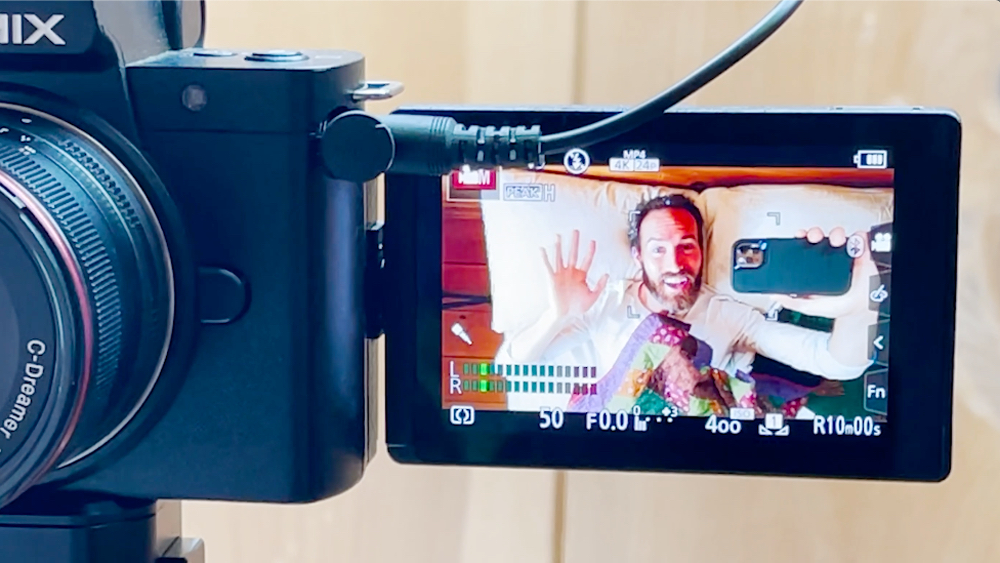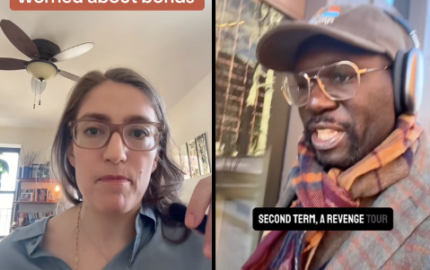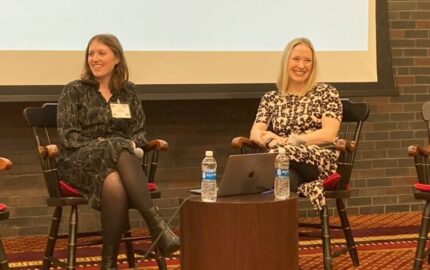EDITOR’S NOTE: This is the third in our five-part video series, Field Testing, in which independent video producer Alexander Trowbridge retreats to a farm to learn the tools and skills necessary for anyone to make compelling visual stories when working alone in the field. Watch Episode 1 here. Watch Episode 2 here. The rest will be publishing soon!
Filming yourself. While making this series, it’s something I’ve had to think about quite a bit. Starting with how, and with what, to hold the camera.
There’s holding it with my hand, which works. It’s quick, except my arm is in the shot, and in use so not great for the times I might want to show the audience something with my hands.
For those times, I attach my camera to a mic stand with a telescopic boom arm (K&M Microphone Stand: $89.99. Combine with a 1/4"-20 Male to 5/8"-27 Female screw adapter, which costs $7.29.) Good for the top-down view, for when I’m trying to show something on my desk or talk to the audience while lying down.
For the simple and straight-on shot, I turn to the classic tripod (Peak Design Travel Tripod: $349.95). It’s steady and gets the job done, as long as you have enough space for the legs, solid ground on which they can stand and only need to reach a certain height. That covers a lot of scenarios, but not all of them.
For situations where even ground isn’t available, I use a strong clamp with an articulating arm. For large loads, I use the Manfrotto 244N Variable Friction Magic Arm, which runs about $130, and the Manfrotto 035RL Super Clamp with 2908 Standard Stud, which costs about $30 depending on where you buy it. For smaller loads, I use the SMALLRIG 9.5 inch Adjustable Articulating Magic Arm ($19) and the SMALLRIG Super Clamp ($9.) The clamp and articulating arm combo has helped me place cameras and gear in spots I otherwise wouldn’t have been able to. You can set them at a highly specific angle and then tighten them so that they stay that way.
But they do require something to clamp on to, which isn’t always easy to find, and because they’re so good at staying in place, they’re not what I use when I’m trying to show the audience around.
Studio on a selfie stick
For that… there’s what I call the selfie-stick studio. It’s a work in progress, which I’ve assembled piece by piece through trial and a lot of error.
The harness, intended for tiny action cameras, doesn’t bear weight well (Insta360 Back Bar Waist Strap: $33).
So I found lighter gear, swapping my regular camera for a simpler model (Pansonic Lumix G100: $747.99) that can still hold a decent lens, and swapping out my regular lens for an alternative that’s much smaller in size but wider in its field of view (Venus Optics Laowa 7.5mm f/2 MFT Lens for Micro Four Thirds, the ultralight version: $519), a key feature when filming yourself at close range. For audio, I found a lighter shotgun microphone (Deity Microphones V-MIC D4 Duo: $89) and placed it as close to myself as I could, generally a good practice when trying to record clear sound. And after finding a portable light (Lume Cube Panel Mini: $59.95) that weighed less than half as much as my original, I decided to double up and found that spacing them apart evened out the illumination. To hold them in place I asked my neighbor for help drilling holes in an old curtain rod.
This has proved to be a versatile rig. For the episode on drones, it allowed me to film myself from the front, talking directly to the camera, and from over my shoulder, as I explained the drone’s controller. Throw a phone on the rig and the versatility grows. An iOS app called FiLMiC DoubleTake (free in the App Store) allows you to record yourself and your subject at the same time. So naturally, I had to try it out in an interview setting.
For that, I approached Dalziel Lewis who founded and runs Dig Deep Farm, the Maine-based organic vegetable farm where I worked this summer. We walked around a storage container she retrofitted to suit her winter growing needs and she told me about her microgreens. When she gave me a sample of her nasturtium shoots, you could see her passing the green from her frame to mine and watch my reaction as the spice hit.
Handing storytelling tools to the story subject
I’d originally conceived of this rig as a means for journalists to tell their stories, but I couldn’t help but wonder what happens when we hand it over to the subjects of the stories we’re telling? When they can show us their world with their own hands? Lewis was nice enough to entertain the notion and it immediately changed the nature of the footage being captured. She lit up as she walked the camera rigged up to her waist from one vegetable variety to the next, from daikon radish to purple kohlrabi.
She did, however, note the added mobility limitations: “It’s definitely reminding me of being pregnant," Lewis said.
And while I realize there’s a certain stigma to pointing a camera at yourself, especially if that camera is a hands-free selfie stick mounted to a harness, I do think it has serious benefits. Learning how to film yourself and do so well can unlock one of your greatest assets as a storyteller: You. And I think more journalists empowered to do so, is a good thing.
Watch episode four next: This mobile editing challenge proves you can produce great video anywhere
***
Alexander Trowbridge is a multimedia journalist and producer. Most recently a fellow with the Nieman Foundation for Journalism at Harvard, he previously worked at "The Late Show With Stephen Colbert," Bloomberg Politics, CBS News and Politico.



